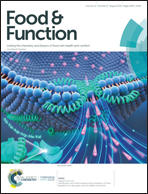Antihyperglycemic and antihyperlipidemic activities of a polysaccharide from Physalis pubescens L. in streptozotocin (STZ)-induced diabetic mice
Abstract
In this study, a polysaccharide was extracted from Physalis pubescens L. (named PP). Its antihyperglycemic and antihyperlipidemic activities were evaluated in STZ-induced diabetic mice. Results showed that PP was determined to be composed of rhamnose (Rha), arabinose (Ara), fucose (Fuc), xylose (Xyl), mannose (Man), glucose (Glc) and galactose (Gal) with molar percentages of 4.65%, 17.34%, 1.43%, 6.24%, 5.52%, 45.5%, and 19.31%, respectively. The average molecular weight (Mw) was found to be 20.0 kDa. It had a strong α-glucosidase inhibitory activity in vitro. PP treatment could enhance the oral glucose tolerance, and increase the levels of SOD, GSH, CAT, vitamin C, vitamin E, HDL-c, C-peptide, GCK and hepatic glycogen in diabetic mice. Besides, PP treatment could also decrease the levels of MDA, TG, TC, LDL-c, BUN and G-6-Pase. The regulating effects were stronger in high dose PP treatment than those in the low and medium dose treatments. In short, PP played an important role in protecting STZ-induced diabetic mice, and the effect was closely related to its activities in antioxidation and regulating glucose and lipid metabolism.



 Please wait while we load your content...
Please wait while we load your content...